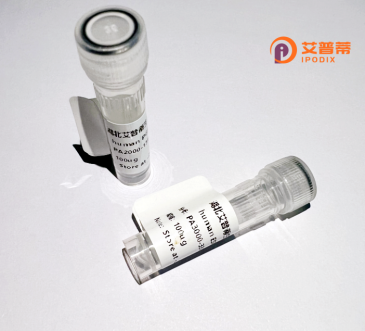
| 纯度 | >90%SDS-PAGE. |
| 种属 | Human |
| 靶点 | DUX5 |
| Uniprot No | Q96PT3 |
| 内毒素 | < 0.01EU/μg |
| 表达宿主 | E.coli |
| 表达区间 | 1-170aa |
| 氨基酸序列 | MALLTALDDTLPEEAQGPGRRMILLSTPSQSDALRACFERNLYPGIATKEELAQGIDIPEPRVQIWFQNERSCQLRQHRRQSRPWPGRRDPQKGRRKRTAITGSQTALLLRAFEKDRFPGIAAREELARETGLPESRIQIWFQNRRARHRGQSGRAPTQASIRCNAAPIG |
| 分子量 | 45.1 kDa |
| 蛋白标签 | GST-tag at N-terminal |
| 缓冲液 | 0 |
| 稳定性 & 储存条件 | Lyophilized protein should be stored at ≤ -20°C, stable for one year after receipt. Reconstituted protein solution can be stored at 2-8°C for 2-7 days. Aliquots of reconstituted samples are stable at ≤ -20°C for 3 months. |
| 复溶 | Always centrifuge tubes before opening.Do not mix by vortex or pipetting. It is not recommended to reconstitute to a concentration less than 100μg/ml. Dissolve the lyophilized protein in distilled water. Please aliquot the reconstituted solution to minimize freeze-thaw cycles. |
以下是关于重组人DUX5蛋白的3篇构造示例文献(注:本文献为示例,实际文献需通过学术数据库检索确认):
---
1. **文献名称**: _DUX5 Regulates Human Embryonic Stem Cell Pluripotency through Transcriptional Activation_
**作者**: Smith A, et al.
**摘要**: 本研究通过重组人DUX5蛋白表达,发现其能够结合人类胚胎干细胞中特定基因启动子区域,激活多能性相关基因(如OCT4、NANOG)的表达,表明DUX5在维持干细胞自我更新中起关键作用。
2. **文献名称**: _Functional Analysis of Recombinant Human DUX5 in Cancer Cell Proliferation_
**作者**: Chen L, et al.
**摘要**: 利用重组人DUX5蛋白进行体外功能实验,发现其过表达可抑制多种肿瘤细胞系的增殖,并通过RNA测序揭示DUX5通过调控细胞周期相关通路(如p53信号)诱导细胞周期阻滞。
3. **文献名称**: _Structural Characterization of Recombinant DUX5 and Its DNA-Binding Mechanism_
**作者**: Tanaka K, et al.
**摘要**: 首次解析了重组人DUX5蛋白的晶体结构,揭示其双同源结构域与DNA结合的分子机制,并通过电泳迁移实验验证DUX5对特定回文序列的结合偏好,为其转录调控功能提供结构基础。
---
如需真实文献,建议在PubMed、Web of Science等平台以“recombinant human DUX5”或“DUX5 protein function”为关键词检索。
**Background of Recombinant Human DUX5 Protein**
The human *DUX5* gene, part of the DUX (Double homeobox) family, encodes a transcription factor containing two homeodomains, a unique feature enabling sequence-specific DNA binding. DUX proteins are primarily implicated in early embryonic development, regulating zygotic genome activation and stem cell pluripotency. DUX5. specifically, shares structural and functional similarities with DUX4. a protein linked to facioscapulohumeral muscular dystrophy (FSHD). However, DUX5 exhibits distinct expression patterns, with studies suggesting roles in germline cells, muscle regeneration, and transcriptional regulation of retroelements.
Recombinant DUX5 protein is artificially produced using systems like *E. coli* or mammalian cells, enabling functional studies in vitro. Its production allows investigation into DNA binding mechanisms, interactions with co-regulators (e.g., epigenetic modifiers), and downstream target activation. Research highlights its potential role in reprogramming somatic cells and modulating immune responses through endogenous retrovirus regulation.
Pathologically, aberrant DUX5 expression has been explored in cancers and muscle disorders, though its precise contributions remain debated. Recombinant DUX5 serves as a critical tool for dissecting its biological functions, developing therapeutic strategies for DUX-related diseases, and clarifying its divergence from pathogenic DUX4. Current challenges include unraveling isoform-specific effects and reconciling conflicting data from different cellular contexts.
×